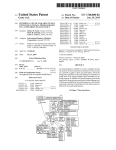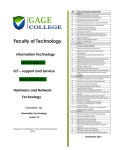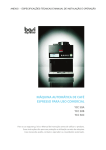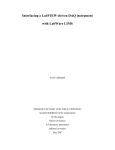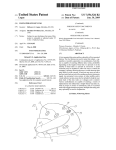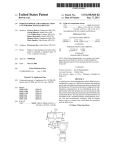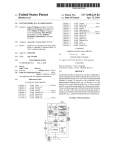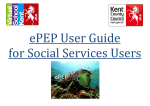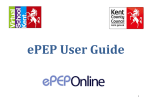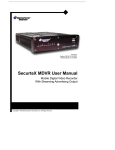Download Method and apparatus for creating a secure anywhere system
Transcript
US008613091B1
(12) Ulllted States Patent
Vaidya et al.
(54)
(10) Patent N0.:
(45) Date of Patent:
Dec. 17, 2013
METHOD AND APPARATUS FOR CREATING
6,925,572 B1
8/2005 Amit et al.
A SECURE ANYWHERE SYSTEM
7,020,895 B2 *
3/2006 Albrecht ....................... .. 726/22
7,032,240 B1*
4/2006
7,213,766 B2 *
7,216,366 B1*
5/2007 Ryan et al. .................. .. 235/492
5/2007 RaZ et al.
726/24
7,272,723 131*
9/2007 Abbott et al ~~~~ ~~
7,320,071 B1*
1/2008 Friedman et al. ..
7,591,018
9/2009
(75) Inventors: Vimal Vaidya, Fremont, CA (US); Kurt
Cronce et al. ................... .. 726/2
$22151? 31'
Lennartsson, Milpitas, CA (US)
(73)
US 8,613,091 B1
Assignee: RedCannon Security, Inc., Newark, CA
(Us)
B1*
Lee
. . . . . . . . . . . . . . . .
713/185
713/165
. . . ..
726/24
*
( * ) Notice:
Subject' to any disclaimer, the term of this
patent 1s extended or adjusted under 35
2002/0100036 A1
2002/0108059 A1
APPI'NO" 10/796’324
(22) Filed:
(51)
if et al' """"""""""" " 726/24
U.S.C. 154(b) by 1905 days.
.
(21)
ZOOZZgigg’ggg
7/2002 Moshir et a1,
8/2002 Canion etal.
2002/0147924 A1*
10/2002
FlyntZ ......................... .. 713/200
2002/0162009 A1*
10/2002
Shmueliet al.
713/200
2002/0188872 Al* 12/2002 Willeby ...................... .. 713/202
Mar. 8, 2004
(Continued)
Int Cl
OTHER PUBLICATIONS
G06F 11/00
(200601)
“U3 Platform,” downloaded from www.u3.com/platform/default.
(52) IGJ0s6FCi3/00
(200601)
aspx on Oct. 27, 2006.
USPC ................. .. 726/24; 726/22; 726/23; 726/25;
(Continued)
711/163; 711/164
(58)
Field of Classi?cation Search
USPC ........... .. 726/26, 22, 23, 24, 25; 711/163, 164
See application ?le for complete search history.
(56)
Re ferences Ct
1 ed
U.S. PATENT DOCUMENTS
5,623,637 A *
5,826,012 A *
5,826,013 A *
4/1997
10/1998
10/1998
Jones et al. ................. .. 711/164
'
726/22
Nachenberg .................. .. 726/22
6,021,150 A
6,038,320 A
2/2000 Partio et al.
3/2000 Miller
H1944 H *
6,189,099 B1*
2/2001
2/2001
Cheswick et al. ............ .. 726/11
Rallis et al. .... ..
.. 713/172
6,347,375 B1*
2/2002
Reinert et al. ................ .. 726/24
6,405,318 B1
6,499,107 B1
6,715,084 B2
6/2002 Rowland
12/2002 Gieichaufet al.
3/2004 Aaron et al.
6,732,301 B1*
5/2004 Landry et al. ................. .. 714/43
6,775,780 B1*
8/2004
Muttik .... ..
'
Prlmary Exam/Her * Teshome Hallu
(57)
ABSTRACT
A method and a
aratus for rovidin
ortable end- oint
PP
P
g P
P
security are provided. In one embodiment, a PEPS system
may include a PEPS processor having a memory operatively
coupled thereto, the memory having stored therein instruc
tions which when executed by the PEPS processor causes: an
automatic loader to automatically trigger loading of the PEPS
system; the PEPS system including a malicious software
detector to scan a main memory of the computing system for
malicious software; and wherein the malicious software
detector performs a scan of the main memory of the comput
ing system following triggering of the PEPS system by the
automatic loader by comparing existing data in main memory
of the computing system with indicia of malicious software.
24 Claims, 15 Drawing Sheets
Downloads Con?g ?le and Signature
Updates from the Server
Uploads log data to Server
Surround Security Server
USB PEPS
US 8,613,091 B1
Page 2
(56)
Amendment after ?nal dated Jul. 13, 2010.
Notice ofAllowance dated Jul. 13, 2010.
Examiner interview summary dated Jul. 13, 2010.
References Cited
U.S. PATENT DOCUMENTS
Miscellaneous incoming letter dated Aug. 12, 2010.
2002/0191548 A1*
2003/0009687 A1*
12/2002 Ylonen et a1. .............. .. 370/254
1/2003 Ferchau et al. ............. .. 713/200
Replacement drawings dated Aug. 12, 2010.
Arguments in support of replacement drawings dated Aug. 12, 2010.
2003/0045273 A1
2003/0087601 A1
3/2003 Pyhalammi et al.
5/2003 Agam et al.
Amendment after allowance dated Aug. 12, 2010.
Issue notice dated Aug. 25, 2010.
2003/0093281 A1*
2003/0120605 A1*
5/2003
6/2003
William R. Stanek; Micro softWindows 2000 Administrator’ s Pocket
2003/0167395 A1
Geilhufe et al. ............ .. 704/275
Fontana et al. ............... .. 705/59
9/2003 Chang et a1.
2003/0188189 A1*
2003/0212821 A1*
10/2003
11/2003
Desai et al. .
. 713/201
Gillies et al. ................ .. 709/238
2003/0229890 A1
12/2003 Lau et al.
Consultant; Jan. 12, 2000; Microsoft Press; Chapter 84Creating
User and Group Accounts in Windows 2000.
Securing the Perimeter, Part 1; May 16, 2001; Symantec Corporation.
Wells, Mark & Thrower, Wood; DefendYour Enterprise with Layered
Security; Jun. 14, 2001; Symantec Corporation.
Symantec Enterprise Security Manager v5.5; Dec. 12, 2001;
2004/0073726 A1
4/2004 Margalit et a1.
2004/0088567 A1*
5/2004
2004/0187012 A1*
9/2004 Kohiyama et al. .......... .. 713/193
Symantec Corporation.
2004/0187018 A1
9/2004 Owen et al.
2005/0066069 A1*
3/2005
2005/0102529 A1
5/2005 Buddhikikot et al.
2005/0156043 A1*
7/2005
2006/0010325 A1
1/2006 Liu et al.
Keys that RememberiAnd a Lot More; BusinessWeeldonline, Dec.
22, 2003 pp. 1-2.
You Can Lug Home Your Of?ce Computer Inside Your Pocket, The
Wall Street Journal, online, Nov. 20, 2003, pp. 1-3.
USB VPN & Firewall Adapter; LINKSYS, a Division of Cisco Sys
tems, Inc. 2003, pp. 1-3.
2006/0015728 A1
2006/0242686 A1*
2007/0186099
2008/0046990
2008/0082183
2008/0082813
2009/0013165
A1*
A1*
A1*
A1*
A1*
Lamotte ...................... .. 713/200
Kaji ................................ .. 710/1
Lin ............................. .. 235/441
1/2006 Ballinger et a1.
10/2006
8/2007
Toda et al. ...................... .. 726/3
Beck et al. ..
. 713/159
2/ 2008 Narayanaswami et
4/ 2008
.
Judge .................. ..
4/ 2008 Chow et al.
1/2009
700/33
.. 713/2
Chowetal. ..................... .. 713/2
Key ComputingiMobility that Works, M-Systems, 2003, pp. 1-4.
Xkey Delivers Mobile Access on Your Key Ring, Channel: Content
and Collaboration (Archive), Jan. 15, 2004, p. 1 of 1.
Symantec Antivirus Solution 7.5 Tour Part 1: Symantec System Cen
ter; Jul. 10, 2001; Symantec Corporation.
Symantec Antivirus Corporate Edition User Manual Version 5. 1; Oct.
OTHER PUBLICATIONS
“TCG EFI Platformifor TPM Family 1.1 or 1.2,” pp. 1-37, Jun.
2006.
“TCG EFI Protocolifor TMP Family 1.1 or 1.2,” pp. 1-18, Jun.
2006.
Stanek, William R., “Microsoft Windows 2000 Administrator’s
25, 2001; Symantec Corporation; pp. 29-35.
AXENT(R)/E SM User Manual Version 5.1; Oct. 25, 2001; Symantec
Corporation; Section 1.5.
Symantec Antivirus Corporate Edition Adminstrator’s Guide; Jul. 2,
2002, Symantec Corporation, pp. 52-53.
Ed Skoudis, Counter Hack: A Step-by-Step Guide to Computer
Attacks and Effective Defenses; Jul. 23, 2001; Prentice Hall PTR, pp.
Pocket Consultant,” Microsoft Press, Chapter 84Creating User and
44-57, 139-140, 226-237, 248-251, 379, 432-433.
Group Accounts in Windows 2000, Jan. 12, 2000.
Ferguson, Paul & Huston, Geoff; What is aVPN? Apr. 1998.
Non-Final Of?ce U.S. Appl. No. 10/739,552 dated Nov. 2, 2006.
Non-Final Of?ce U.S. Appl. No. 10/739,552 dated May 4, 2007.
Final Rejection U.S. Appl. No. 10/739,552 dated Jan. 17, 2008.
Non-Final Of?ce U.S. Appl. No. 10/739,552 dated Sep. 3, 2008.
Non-Final Of?ce U.S. Appl. No. 10/739,552 dated Aug. 28, 2009.
IDS Statement Aug. 31, 2004.
Securing the Perimeter, Part 1, Symantec Corporation, May 16, 2001.
Wells, Mark, et al, “DefendYour Enterprise With Layered Security,”
Symantec Corporation, Jun. 14, 2001.
Symantec Enterprise Security Manager 5.5, Symantec Corporation,
Dec. 12,2001.
Symantec AntiVirus Solution 7.5 Tour Part 1, Symantec System
Center, Symantec Corporation, Jul. 10, 2001.
Symantec AntiVirus Corporate Edition User Manual, “Symantec
AntiVirus Corporate Edition and Realtime Protection,” Symantec
Corporation, Jul. 2, 2002, pp. 29-35.
AXENT(R)/ESM User Manual Version 5.1, Symantec Corporation,
Section 1.5, Oct. 25, 2001.
Symantec AntiVirus Corporate Edition Administrator’s Guide,
Symantec Corporation, Jul. 2, 2002, pp. 52-53.
Ferguson, Paul, et al., “What is VPN?”, Apr. 1998.
News Release: Symantec Announces Norton Utilities for Windows
NT 4.0, Symantec Corporation, Jan. 27, 1997.
Applicant’s reply to Of?ce Action dated Dec. 22, 2009.
Final Rejection dated Apr. 1, 2010.
“Micro Vault with Fingerprint Access,” Sony GlobaliMicro Vault,
pp. 1-4, 2004.
“Keys That RemberiAnd a Lot More,” BusinessWeeldonline, pp.
1-2, Dec. 22, 2003.
“You Can Lug Home Your Of?ce Computer InsideYour Pocket,” The
Wall Street Journal, online, pp. 1-3, Nov. 20, 2003.
“USB VPN & Firewall Adapter,” LINKSYS, a Division of Cisco
Systems, Inc., pp. 1-3, 2003.
“KeyComputingiMobility that Works,” M-Systems, pp. 1-4, 2003.
“Xkey Delivers Mobile Access onYour Key Ring,” Channel: Content
and Collaboration (Archive), p. 1 of 1, Jan. 15, 2004.
* cited by examiner
US. Patent
Dec. 17, 2013
Sheet 3 0115
US 8,613,091 B1
.5
N
US. Patent
Dec. 17, 2013
Sheet 6 0115
US 8,613,091 B1
w
mmv
m
9958.07:520 @E2691“.!
8:352
mmv
oww l/
22
mmv
US. Patent
@k2Qb2Eo35QwE 9326> 0%
Dec. 17, 2013
a
Sheet 8 0115
US 8,613,091 B1
A
.E
w
US. Patent
Dec. 17, 2013
c$ou20cou on“
Sheet 9 0115
US 8,613,091 B1
as2558m0 0K
EV3:268m52u, at
3.E5o 250 03
>
A
B94a8m3s
.91
N
US. Patent
Dec. 17, 2013
Sheet 10 0115
856x28 own
92238m%0 05
A
M
m_
a
$59
m
03
US 8,613,091 B1
2
=
$5 8
QEEm 3m
.5
w
US. Patent
Dec. 17, 2013
Sheet 14 0115
US 8,613,091 B1
5%mo$3525
waz wmn :i
x83;
.20we8%25q ,
02.91
my
.
1238 .;
“V.3562\
{832.5
US 8,613,091B1
1
2
METHOD AND APPARATUS FOR CREATING
A SECURE ANYWHERE SYSTEM
FIG. 5 is a ?owchart of one embodiment of the process
scanning portion of the spyware scanning engine.
FIG. 6 is a ?owchart of one embodiment of installing the
vault on the PEPS.
FIG. 7 is a ?owchart of one embodiment of outbound data
FIELD OF THE INVENTION
communication processing.
The present invention relates to computer security, and
FIG. 8 is a ?owchart of one embodiment of inbound data
more particularly to securing a computer in an insecure envi
communication processing.
ronment.
FIG. 9 is a ?owchart of one embodiment of the unload
process.
BACKGROUND
FIGS. 10A-C are block diagrams illustrating where the
protection takes place in the OS and communication stack.
As the Internet became prevalent and accessible from
almost anywhere, the choice of connectivity to the Internet
grew as well. Corporate boundaries expanded beyond the
FIG. 11 is a ?owchart of one embodiment of interaction
between the PEPS and a server.
physical campus network, Roaming employees could con
DETAILED DESCRIPTION
nect to the corporate network from almost anywhere using a
Virtual Private Network (VPN). An employee could be on his
desktop in the o?ice; at home on his home machine; at an
A method and apparatus for creating a secure working
environment on a potentially insecure computer is described.
airport, a cybercafe, or a hotel room with his laptop; or at a 20
The present invention is a portable end-point security (PEPS)
Kiosk computer and he/she could still connect to the corpo
device that includes software to establish a secure perimeter.
Upon connecting the PEPS to a computer, in one embodi
ment, the software automatically installs itself on that end
rate network and access emails as well as other useful data.
This extremely powerful connectivity is extremely danger
ous. Being able to access emails and corporate data from a
Kiosk or a cybercafe is very useful and convenient, however,
it has risks. The computer being used is not under the control
25
point computer, and creates a secure environment for the user.
In one embodiment, the PEPS creates a secure cache within
that computer for all temporary user data and facilitates
of the user at all times. The computer or kiosk could monitor
secure authentication and communication with a server, or
the data that comes through. It could include various types of
spyware, which logs keystrokes, or interactions. This makes
anything and everything an employee does on the network
vulnerable to be captured regardless of whether or not VPN is
used. Even if the computer is the user’s own laptop, if the
access point has spyware on it, what the employee does could
remote system. In one embodiment, PEPS is implemented in
a USB (universal serial bus) key. Alternatively, PEPS may be
30
implemented as an Attachable Hard Drive, PCMCIA (Per
35
card, a Firewire connection, or any other mechanism that
permits the coupling of the portable PEPS to a computer
system. In one embodiment, PEPS may be implemented in
software using a Java applet, ActiveX, Web application or
sonal Computer Memory Card International Association)
still be compromised. Furthermore, using the captured data,
the entire corporate network may become vulnerable. Even
without an active spyware application, by showing what sites
similar technology.
FIG. 1A is a block diagram of a network including a com
puter system on which the PEPS may be used. There are ?ve
a user visited (history) and what cookies were activated,
signi?cant amounts of information can be obtained.
layers of protection, around Host B 100, the computer into
Security threats at the end-point computers have been a key
issue for many enterprises and computer users. However with
the network boundaries disappearing, the threat of inadvert
ent exposure of the corporate data is greater than ever before.
Therefore, a better way of securing data in an environment
where the computer or the network is not under the user’s
control at all times would be advantageous.
40
which the PEPS has been inserted.
First the checking for potential spyware takes place (110).
After successful checkiie. no spyware found or spyware
removedithe PEPS is authenticated, enabling its use. The
user can then select a secured application from the PEPS.
45
Secured applications include, in one embodiment, ?les in the
Vault (secure storage), Browser and Email clients, and other
applications available from the PEPS. In one embodiment,
SUMMARY OF THE INVENTION
any application used with the PEPS can be a secure/stealth
A method and apparatus for portable end-point security.
50
BRIEF DESCRIPTION OF THE DRAWINGS
applications are applications residing on the PEPS or on the
insecure computing system, whose outputs are all redirected
to the Secure Cache, including temporary ?les, so that they
The present invention is illustrated by way of example, and
not by way of limitation, in the ?gures of the accompanying
drawings and in which like reference numerals refer to similar
elements and in which:
55
puter system on which a portable end-point security (PEPS)
60
FIG. 4 is a ?owchart of one embodiment of the spyware
scanning engine.
(120) that protects communication.
A privacy and stealth system (130) controls cookies, harm
ful code, and will not leave any trace behind on the computer
that has been used. The system ensures that not even temp
?les are left behind after use. The system can even use the
computers own browser for full functionality. The browser is
FIGS. 3A and 3B are a ?owchart of one embodiment of
using the PEPS system.
leave no traces on the computer. The secure cache can reside
on the PEPS or be created on the insecure system under
control by the PEPS and will, in the latter case, be securely
deleted after the PEPS has been unplugged.
The system further includes an application level ?rewall
FIG. 1A is a block diagram of a network including a com
may be used.
FIG. 1B is a diagram of the interaction of the computing
system including PEPS and a server.
FIG. 2 is a block diagram of the software components of the
PEPS 200.
application. Secure applications are applications that are
uploaded from the PEPS, and are therefore controlled. Stealth
65
used securely by redirecting anything that leaves traces, such
as temp ?les, temp Internet ?les, cookies etc to the PEPS.
Secure communication (140) comes from using the tech
US 8,613,091 B1
3
4
niques above in for the Browser in combination With SSL to
communicate back to the organization. Secure data (150) is
the data that is stored in the Vault on the PEPS.
FIG. 1B illustrates the interaction betWeen the PEPS and
the surround security server. The surround security server
leaving a trace on the host computer. Level 3 security may be
used to keep your privacy on the host computer. In one
embodiment, Level 3 security may also include scanning for
keyboard loggers and SpyWare, getting secure email, using
the Web and SSL VPN to connect back to the enterprise, etc.
All of these features are available Without leaving any traces
on the host computer. Level 3 security may be used When
there is no chance of installing anything on the computer due
to limited rights, Whether it is a company computer or not. In
may be a central server, or may be a server provided by a
corporation for its employees. The PEPS connects to the
surround security server, and doWnloads con?guration ?les
and signature updates. In one embodiment, the PEPS may
also upload log data to the server. This process is described in
general, Level 3 security provides no chance of monitoring
more detail beloW With respect to FIG. 11. The process starts
When the PEPS Wishes to connect to the server for an update.
the user. HoWever, if the PEPS system belongs to an enter
prise (or there is an administrator other than the user), the
enterprise can obtain traces and data from the logs on the
PEPS.
In one embodiment, the PEPS is periodically triggered to
connect to the server, if a secure connection is available. In
another embodiment, every time the opportunity presents
itself, the PEPS connects to the server.
At block 1120, a secure connection is established With the
server. In one embodiment, the secure connection is estab
lished once the PEPS security is installed, as described beloW.
If Level-1 or Level-2 security is established, and secure shell
(SSH), secure sockets layer (SSL), or another secure connec
tivity method is available, the PEPS can establish a secure
20
and ensures that any malicious applications and harmful
embedded code such as SpyWare and ActiveX components
connection With the server.
At block 1130, the PEPS check for, and doWnloads any
updates for applications, and malicious software signatures.
are nulli?ed. Level 2 security may further as enforce content
25
Level 2 security provides more extensive ?ltering of the
communication and stops potential SpyWare from communi
cating. Communication requests can be matched to the appli
neW data from the server.
30
con?guration ?le, if available.
At block 1150, the PEPS applies the changes and updates.
In on embodiment, the PEPS immediately authorizes and
implements neW policies through connecting to the server and
doWnloading the neW policy right after the PEPS is connected
cookie control may modify the content of the cookies for
increased privacy. Level 2 security can, in one embodiment,
block harmful code, and block advertising as Well.
35
Vault 215. This alloWs the PEPS to handle security of infor
mation in a methodical manner.
40
embodiment, a security application 222 is stored along With
45
carries the corporate policies regarding usage and communi
tials 230 such as passWord for installation, passWord for
accessing the Data Vault, passWord or digital certi?cate for
50
55
establishing credentials to a corporate back-end, are stored in
the system vault 210 as Well. The system vault 210 is for
system use only, and requires a manager application to
modify or add data.
The data vault 215 is Where user speci?c data is stored. In
one embodiment, access to the data vault 215 requires secure
passWord-based authentication. HoWever, in one embodi
60
ment, the user can vieW the listing of ?les and directories in
the data vault 215 once the user is initially authenticated for
PEPS installation. In one embodiment, the user Would be
granted a limited number of attempts to provide the correct
passWord. For example, the number of attempts may be set at
three. In one embodiment, the number of attempts permitted
system Would have access to the logs and other ?les on the
PEPS. In one embodiment, the logs may include, for example,
sites visited, etc.
FIG. 2 is a block diagram of the softWare components of the
PEPS 200. In one embodiment, the system has three levels of
security Which may be invoked. Level 3 permits the user to
use the applications available on the system securely, Without
credentials. In one embodiment, the PEPS application
includes elements in formats such as Java applet, application
or a WindoWs DLL. An XML con?guration ?le 225, Which
cation, is stored in the system vault 210 as Well. User creden
Ware etc. In one embodiment, the administrator may be able
to shut doWn the users SSL connection to the company
remotely. Thus, While the system provides security and
stealth against outsiders, the administrators of the enterprise
The system vault 210 is a hidden, non-user-Writeable area
of memory Where the PEPS applications are stored. In one
enforcement data 220 such as con?guration ?le and user
Ware disabled and connections prohibited, as Well as anything
else of relevance to blocking. In one embodiment, this data is
available to the user, from the server’s Web site. In another
embodiment, the Web site collects this data Without any user
identifying information. In another embodiment, the user
may turn off logging.
In one embodiment, the PEPS is centrally managed by an
enterprise or the like. For example, a corporation may provide
PEPS to its employees, and also provide the server that
updates the PEPS and collects log data. In one embodiment,
the administrator can revieW logs and get alarms about Spy
In one embodiment, the memory subsystem 205 on PEPS
is split into tWo primary regions, System Vault 210 and Data
signature immediately upon successfully doWnloading the
updated signature ?le.
At block 1160, the PEPS uploads log and status ?les. In one
embodiment, the PEPS logs the instances of malicious soft
cations that are authorized to communicate. Content ?ltering
can also be enforced on the broWser. In one embodiment,
to a computer. In one embodiment, this update occurs every
time the PEPS is securely connected to a computer system. In
one embodiment, in addition to updating its internal settings,
the PEPS veri?es its current connection using the neW data.
That is, for example, if an additional malicious softWare
signature Was added, the PEPS starts checking for the neW
?ltering and content control such as modifying the cookies
(for increased privacy).
In one embodiment, a CRC, version number, or similar iden
ti?er is used to determine Whether the PEPS has the most
current information. If it does not, the PEPS doWnloads the
At block 1140, the PEPS checks for and doWnload a neW
Level 3 provides customized applications, from the PEPS
to provide security. HoWever, Level 3 can be implemented
Without admin rights on the computer system.
Level 2 security provides application control, as Well as
content ?ltering and content control mode, using the existing
applications on the computer system. Level 2 security, in one
embodiment, provides a better ?lter for the communication,
may be altered by an administrative user, as Will be described
65
beloW.
After, the number of failures, the system locks out the user.
Once the Vault 215 is in this state, in one embodiment, the
system uses a data recovery key to access the Vault. The data
US 8,613,091 B1
5
6
recovery key, in one embodiment, requires administrative
10/739,552, ?led Dec. 17, 2003, entitled “A Method And
access to reset the Data Vault 215 password. In one embodi
ment, no one can penetrate the vault once it is locked, Without
the data recovery key. This provides security in case the PEPS
Apparatus To Secure A Computing Environment”, assigned
to the assignee of the present application. That application is
incorporated herein by reference. In another embodiment, the
is lost and recovered by a non-trusted third party. In one
embodiment, secure remote help may be provided to reset the
user passWord. The PEPS could also be used, in one embodi
ment, as part of the authentication system to authenticate the
process determines Whether an operating system is installed
that enables full surround security installation from the PEPS.
If so, the process continues to block 332, as if the Fireball
Surround Security ApplicationTM Were installed on the sys
user to WindoWs, at Level-1. In one embodiment, the PEPS
could replace a smart card for authentication purposes. In one
tem.
If the surround security application is installed, the process
embodiment, the hooks in WindoWs to provide third party
authentication may be used to provide this service.
FIG. 3A is a ?owchart of one embodiment of using the
PEPS system. The process starts at block 305. At block 310,
the PEPS application is launched. In one embodiment, this
occurs automatically When the PEPS is coupled to the com
continues to block 332. This, described as Level-1, provides
the highest level of protection and functionality for the user.
Since the surround security system is enabled, the user can be
sure that the computer system is secure and fully functional.
At block 332, the functions of the PEPS are disabled,
puter system. The PEPS may be coupled to the computer
system physically via USB, FireWire, USB 2.0, PCMCIA, or
provided by PEPS are instead run on the underlying surround
except for the Vault. The security applications that Would be
similar connection. Alternatively, infrared, Bluetooth, Wire
less, or other connectivity may be used. In one embodiment,
20
the PEPS system is coupled directly to the computer system.
At block 312, the scan for spyWare is performed. In one
embodiment, this scan is repeated periodically. For example,
the spyWare scan may be repeated every 30 seconds. The
spyWare scan is shoWn in more detail in FIGS. 4 and 5.
25
one embodiment, authentication requests a user ID and pass
Word. Altemately, the authentication may request a passWord
only. Alternative means of authentication, knoWn in the art,
The system furthermore continues to monitor for user com
30
continues to block 320.
At block 320, the PEPS is locked. In one embodiment, the
PEPS can subsequently be unlocked by someone With admin
istrative rights, on a secured computer system. In another
35
At block 342, the process determines Whether the user has
40
45
administrative rights on the computer system. Administrative
rights enable the user to install applications on the computer.
If administrative rights are available, the process continues to
block 344. This level of security is designated Level-2, indi
cating an intermediate level of security. All of the security
features available With Level-1 are installed, except the net
Work layer ?reWall and intrusion detection system, since
these require a reboot and mo st of the time that is not an option
available on public computers. In another embodiment, if the
operating system permits Level-1 security even Without the
preinstalled system, the Level-2 security may be selected
trator may be used to unlock the PEPS, or reset the users
50
autorun is locked. The autorun is the automatic launch
enabler, Which automatically launches the PEPS application
When the PEPS is coupled to a computing system. At block
324, the portions of the PEPS applications that Were added to
PEPS.
If, at block 330, the process did not ?nd the surround
security system installed, the process continues to block 342.
embodiment, secure Remote Help provided by the adminis
passWord. In one embodiment, only a preset number of
remote unlock attempts are permitted. At block 322, the PEPS
mands, block 340. If a user command is issued, the process
continues to block 341. At block 341, the process executes the
command/action. These actions may include encryption/de
cryption of ?les, opening ?les, etc. The process then returns to
block 338, to monitor Whether the user has unplugged the
PEPS, can set a number of tries available. In another embodi
ment, another number of tries may be set by the system.
If the number of tries available have not been used, the
process returns to block 314, to again request user authenti
cation information.
If the number of retries has been exhausted, the process
explorer is described in more detail in FIG. 6, beloW. The user
is then able to use the system.
The system continues to monitor, to determine Whether the
user has unplugged the PEPS, block 338. If so, the process
continues to the unloading stage. The unloading process is
described in FIG. 9, beloW.
At block 314, the process requests user authentication. In
may be used.
At block 316, the process determines if the authentication
Was successful. If the authentication is successful, the process
continues to block 330. OtherWise, the process continues to
block 3 18, to determine Whether there have been three unsuc
cessful attempts at authentication. In one embodiment, the
user gets three opportunities to correctly authenticate to the
PEPS. In one embodiment, the user, When setting up the
security system. At block 334, the surround security manager
application is noti?ed that the PEPS has been plugged in.
At block 336, the vault explorer is launched. The vault
55
the computer system are unloaded, to leave a pristine com
because of user preference or speed considerations.
At block 344, the PEPS Enforce DLL is installed.
At block 346, the application ?reWall is initialiZed. At
block 348, the cookie control and content ?lter is initialiZed.
At block 350, the harmful code ?lter is initialiZed. At block
352, the enforcement mechanism is installed. In one embodi
ment, the enforcement mechanism is a dynamically linked
library (DLL). These methods are described in more detail in
puter system, Without any evidence of the PEPS. The process
co-pending application Ser. No. 10/739,552, incorporated by
then ends at block 326.
reference.
The process then continues to block 336, and the vault
If, at block 316, the user Was successfully authenticated,
the process continued to block 330. At block 330, the process
determines Whether the computer system has a surround
security application installed. In one embodiment, the system
determines Whether the Fireball Surround Security Applica
tionTM manufactured by RedCannon, the assignee of the
present application, is installed. A description of a system that
may be the underlying security application on the computer
system is described in co-pending application U.S. Ser. No.
60
explorer is launched.
If, at block 342, the process determined that no adminis
trative rights Were availableiie. the system is not permitted
to install applications onto the computer systemithe process
65
continues to block 354. This level of security is referred to as
Level 3, When the process has very limited user rights.
Secured versions of the applications that are most common
are made available from the PEPS.
























